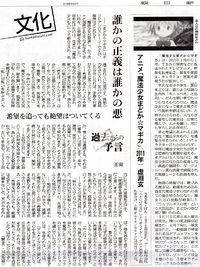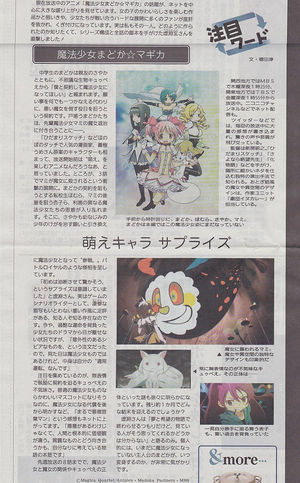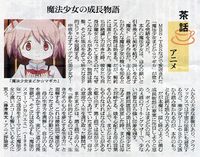Newspapers: Difference between revisions
Randomanon (talk | contribs) |
Randomanon (talk | contribs) mNo edit summary |
||
| Line 1: | Line 1: | ||
== August 30, 2011 Asahi Shimbun Article == | == August 30, 2011 Asahi Shimbun Article == | ||
[[File:Asahi Shimbun 8.30.2011.jpg|thumb| | [[File:Asahi Shimbun 8.30.2011.jpg|thumb|200px]] | ||
<br> | Translation soon.<br><br><br><br><br><br><br><br><br><br><br><br><br><br><br> | ||
== March 2, 2011 Yomiuri Shimbun Article == | == March 2, 2011 Yomiuri Shimbun Article == | ||
Revision as of 09:26, 30 August 2011
August 30, 2011 Asahi Shimbun Article
Translation soon.
March 2, 2011 Yomiuri Shimbun Article
Source: Yomiuri Shimbun, Mar. 4, 2011. [1]
THROUGH OTAKU EYES / There's something magical about 'Madoka'
Makoto Fukuda / Yomiuri Shimbun Staff Writer
One of the latest anime series to cause a stir on both TV and the Internet is the new Puella Magi Madoka Magica. At first glance, it appears to be just any old anime populated with young, pretty girls. Yet it is the unforgiving storyline in which girls fight each other that has left many fans astonished and hooked. I'm no different: I wait each week for the next installment with baited breath.
As soon as I realized the appeal of this series, I immediately set out to interview Gen Urobuchi, the man responsible for its scripts and story arc.
The show starts the way any other so-called magic girl story would begin: A middle-school girl named Madoka and her friend Sayaka are approached by a strange creature named Kyube, who offers them magic powers, which they must use to battle evil witches.
In exchange, each new magic girl will receive a single wish. Bewildered by the prospects, the two girls decided to accompany an experienced magic girl named Mami on a witch hunt.
After learning that the characters were designed by popular mangaka Ume Aoki (Hidamari Sketch), I immediately jumped to the conclusion the show would be pure moe--fetishistic cuteness. But in Episode 3, however, the story took a shocking turn when Mami was slain by a witch.
At this point, a number of other magic girls enter the picture, including Homura, a transfer student who tries to stop Madoka from making her witch deal, and Kyoko, who tries to take Mami's place. Sayaka decides to join the battle to obtain a wish to heal her childhood friend, with whom she has fallen in love.
"I wanted to catch viewers off guard and then reward them," Urobuchi said.
As a game scenario writer, Urobuchi is noted for heavy, often gruesome, storylines and a devoted following. I have been unable to tear myself away from this story of young girls facing hardship. Urobuchi said he was tasked with creating a serious anime that contained an element of surprise. He decided to apply his usual style to the often cliche magic girl genre.
Proving popular with anime fans is the eerie Kyube and the expressionless countenance the character has when pressing these girls into service. In any other series from this genre, Kyube likely would have been the show's mascot. Many fans on the Internet see the mysterious character as an evil salesperson who reveals the price of wish fulfillment only after these girls agree to become magic girls.
These same fans, however, are convinced Kyube does not mean to harm anyone, but merely has a fundamentally different set of values than humans. They see Kyube as an embodiment of the manga, which has its own approach to dealing with things that are alien.
The anime is directed by Akiyuki Shinbo, whose works include Hidamari Sketch, So long, Mr. Despair and Bakemonogatari. He is known for his distinctive direction, characterized by the inclusion of small surprises throughout his work. The witch and space design is by the Gekidan Inu Curry art duo.
By Episode 8, mysteries had begun to unveil, including those about the relationships between the magic girls and the witches, as well as Kyube's true identity. The series is scheduled to end in about a month, and I am very curious about how it will conclude. Personally, I'm anxiously awaiting Madoka's transformation into a magic girl.
Urobuchi would not say any more about where the series was headed, except that it is a story about dreams and hopes. He added, however, "I'm not sure if the viewers will agree with me about that."
Fukuda is a Yomiuri Shimbun staff writer specializing in anime and manga.
April 20, 2011 Yomiuri Shimbun Ad
Ad placed shortly before episode 11 and 12 aired.
Aniplex placed a full page ad in Yomiuri Shimbun (largest newspaper circulation in the world) which 2ch sources estimated an expenditure of 49,455,000 yen (approximately 600K USD).
There were reports that Yomiuri Shimbun sold out in many places because of this ad.
May 2011 Asashi Evening Newspaper
From Asahi Evening (朝日夕刊) newspaper, early May 2011.
Summary from symbv from evageeks.forum:
Besides the introduction of what PMMM is about, the author (who was billed as an anime critic) presented the following insights:
- PMMM saw quite a lot of influence from gal game and he believes an "orthodox" interpretation of the anime should be taken from the perspectives of gal game and sci-fi.
- One important ingredient of enjoying the anime, in his view, is the undercurrent of the character development of the protagonist Madoka. And he believes the key to it is Madoka's mother who left a strong impression even though she made only infrequent appearances.
- He compared the Madoka in Ep.11 when she would reply to a worrying mother's words with a determination about thing that she had to do and wanted to do, and the Madoka in Ep.1 when she would meekly (but happily) accepted her mother's advice of wearing a ribbon to school.
- He then picked up Madoka's mother words in Ep.3 "living life not to make your dream the goal but to turn this way of living life into your dream", and commented that this was clearly understood by Madoka then. This led to the actions she managed to do in Ep.12.
- He believes PMMM could be viewed as an orthodox coming-of-age story. Here Madoka got to understand how her beloved mother lived her life and at the end through this Madoka made the decision of how she wanted to live her life.
- He also saw similarity of PMMM to the 1985 mahou shoujo anime "Magical Emi, the Magic Star" in its theme of dealing with growing up.
Another translation summary: Seems to be a column deciphering some story-points. It talks about the girls contracting and then being forced to fight witches and the hidden magical girls equals witches rule. With this as the focal point in the last part of the story it gets its sci-fi twist. There is also something about galges being an influence. It also talks about the character growth. Madoka's mum leaving a strong impression as a working mother and with her rough speech, coming into confrontation with Madoka in ep 11. It relates to episode 1 where her mom choose the ribbons for her, but now she chooses her path for herself. That's also in relation to the episode 3 talk about her mom's lifestyle choice/dream and how she gets satisfaction out of that. There is also a mention of magic star magical emi having a similar theme.










